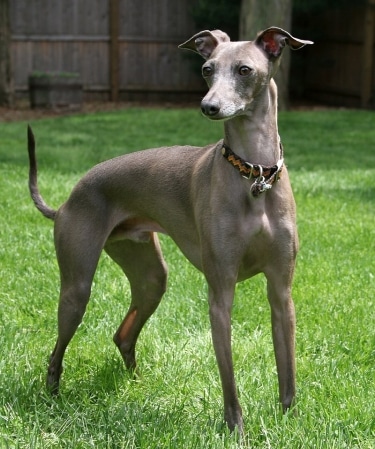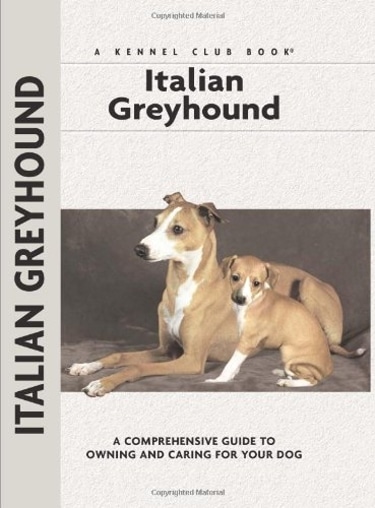
The Italian Greyhound has an ancient lineage dating back more than 2,000 years ago to modern day Greece and Turkey.
Depictions of Italian Greyhounds found on many ancient artifacts and archaeological discoveries of their skeletons confirms their existence during this time. Some claim Italian Greyhounds were used to hunt small game, others claim they were simply used as family pets.
During the sixteenth century, the breed was so popular in Italy that they became known as “Italian Greyhounds”. They were also quite popular in Southern Europe at this time. By the seventeenth century, Italian Greyhounds arrived in England – also becoming a favorite there as well.
Italian Greyhounds were first registered with the American Kennel Club in 1886 and The Italian Greyhound Club of American was founded in 1954.
Height: The height of an Italian Greyhound is 12-15 inches (30-38 cm).
Weight: The weight of an Italian Greyhound is 6-10 pounds (3-5 kg)
Coat Type: The Italian Greyhound’s coat is short, fine, glossy and soft all over the body. The coat does not add any protection against the elements, therefore Italian Greyhounds do not like the cold nor do they like swimming. Grooming of the coat is minimal – an occasional bath or wipe down with a damp cloth is all that’s necessary. The Italian Greyhound’s coat is odorless.
Color: AKC standard: “Any color and markings are acceptable except that a dog with brindle markings and a dog with the tan markings normally found on black-and-tan dogs of other breeds must be disqualified.”
Temperament: Italian Greyhounds are docile and very affectionate. They make a great companion dog, love attention and do well with behaved children. Because of their small size, rough play should be avoided since injury could result. Italian Greyhounds are intelligent and training is generally easy, however, it should be done in a firm, yet gentle and consistent manner. House training can be challenging. These dogs must always recognize his owner as his pack leader, otherwise there may be behavioral problems. Italian Greyhounds are eager to please and thrive on attention. They are alert, usually aloof with strangers and will bark at them and at unfamiliar sounds – making them an acceptable watch dog. Italian Greyhounds are incredibly fast, agile and athletic. When it comes to exercise, daily walks as well as free play are essential. It’s important to note that due to their coat which does not add any protection against the elements, Italian Greyhounds are not outdoor dogs. They do not like the cold and they will cuddle up to to you or under blankets even on the warmest of days. In addition, they do not like getting their feet wet at all.
Health Problems: Italian Greyhounds are generally healthy. The biggest health concern involves their teeth and gums. It is imperative for proper and preventive care to help avoid this issue, otherwise, the likelihood of developing periodontal disease is extremely great – even at a young age. Other health concerns include: fractures, hypothyroidism, idiopathic epilepsy, progressive retinal atrophy (PRA), luxating patellas and Legg-Perthe’s disease (LPD). Life expectancy of a Italian Greyhound is between 12-15 years.
Special Interests:
• Italian Greyhounds can easily walk upright on their hind legs & they are capable of jumping very high.
• Italian Greyhounds are the smallest of the family of gazehounds (sight hounds).
• An Italian Greyhound was first registered with the American Kennel Club in 1886.
• The Italian Greyhound Club of American was founded in 1954.
• The Italian Greyhound’s coat is odorless.
• Italian Greyhounds are often called Iggy, Iggies or IGs.
• Italian Greyhounds have been portrayed in paintings by Velázquez, Pisanello and Giotto.
Classifications:
AKC: Toy Group
ANKC: Group 1 – Toys
CKC: Group 5 – Toys
FCI: Group 10 – Section 3: Short-haired Sight hounds
KC: Toy
NZKC: Toy
UKC: Companion Breeds
 Kennel.com – Complete Guide to Dogs The Dog Lovers Guide
Kennel.com – Complete Guide to Dogs The Dog Lovers Guide
 Italian Greyhound
Italian Greyhound